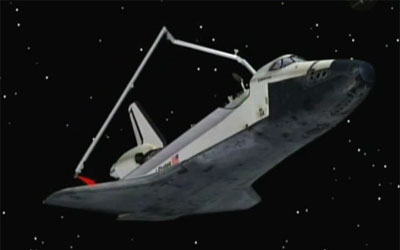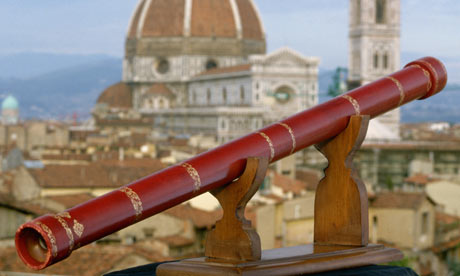 Naked eye astronomy By Katie Fraser
Naked eye astronomy By Katie FraserGalileo first turned his telescope to the skies 400 years ago. But even those without fancy equipment can watch the stars - here are five notable formations to look for.
Wherever you are in the world, there will always be stars in the night sky above. And spotting these heavenly bodies - be it a solitary star amid the light pollution or great drifts dotted across the inky darkness - can give a certain thrill.
Marek Kukula, Royal Observatory
And stars are not the only attraction - there are planets, comets and galaxies too. Most have been in the skies above for millions and millions of years, which is part of the draw for stargazers, amateur and aficionado alike.
It is this connection with the rest of the Universe that Marek Kukula, the public astronomer at the Royal Observatory Greenwich, believes is the greatest draw.
"Astronomy is a science about the big questions in life, such as where do we come from and where does the Earth come from," says Dr Kukula. "It is a way of getting in touch with nature and the Universe in a very real way."
To mark the 400th anniversary of Galileo Galilei's first recorded discoveries in the sky through a telescope, 2009 has been declared the International Year of Astronomy by the United Nations and International Astronomical Union. People around the world are being encouraged to do some star-gazing of their own.
But other than going to an observatory or using the latest telescopic kit, what can we see in the night sky with the naked eye alone?
Part of the charm of astronomy is its simplicity, says Dr Kukula.
"It is one of the few things where we can go out into our own gardens and do it ourselves. You can lie on your back and there's a chance you'll spot a shooting star."
Julia Gaudelli, an amateur astronomer from Guildford, suggests investing in a star map or planisphere (a circular chart that rotates to display the stars to see at certain times), and a pair of binoculars. But neither are essential, and numerous websites detail what's going on in the sky each night.
For optimal viewing it is best to get outside later in the night - the darker the sky, the better the star-gazing. This is why city centres are not ideal.
"If you go somewhere genuinely dark, you will notice the change. It can be the difference between thousands of stars compared to a dozen or so," says Dr Kukula.
Here are five constellations to look for:
ORION
Although stars are always drawn, or painted, in a light yellow or white shade, there are many which are coloured, even to the naked eye. This is true in the case of one of the best known of all the constellations, Orion - also known as the Hunter.
Here, the top left star in Orion - the right shoulder - Betelgeuse - is a giant red star. In comparison, the bottom right star of the constellation, Orion's right foot - Rigel - is blue.
There are three stars that represent Orion's "belt", and three below which make up his "sword". Of those that are the sword, one is not a star but a nebula, where stars are formed. Dr Kakula describes it as a nursery: "It is probably very much like where our own stars and earth began."
URSA MAJOR
Ursa Major - also known as the Plough - can be seen in the UK all year round.
It is identifiable by the double star that represents the handle of the plough, which some people know as the horse and rider.
With the naked eye, it's clear that there are two stars here, but if you turn binoculars or a telescope on this constellation, it becomes clear that there are three.
ANDROMEDA GALAXY
The Andromeda Galaxy is about the most distant object - at 2.5 million light-years away - that it is possible for anyone to see in the night sky.
Much of the lure of this galaxy is its impressive distance from us, says Dr Kukula, that the time the light took to reach us began so many years before man even inhabited the Earth. "Astronomy really is a time machine. You are seeing all the stars in a different time, depending how long it's taken the light from them to get to us."
As the seasons change, so do the stars which are most visible. Ms Gaudelli says the best time to view the Andromeda Galaxy is in the autumn. Look out for a "smudge of light or a faint cloud" to find the right stars, she says.
PLEIADES
Seven stars which are clearly identifiable are called Pleiades, also known as Seven Sisters, and individually named after the sisters in Greek mythology: Sterope, Merope, Electra, Maia, Taygete, Celaeno, and Alcyone.
Dr Kakula says that these are relatively young stars, only a couple of million years old, and are a brilliant blue colour. "They look like a little cluster of sapphires," he says.
These stars are most clearly visible in the Northern Hemisphere from late summer into autumn. And Ms Gaudelli also sought it out on the other side of the world. "I actually saw Pleiades in Australia last week - upside down - which felt very strange."
THE MILKY WAY
The galaxy that is the Milky Way - the galaxy the Earth is part of - is another well-known feature of the night sky. It arches right overhead us, across the sky.
Ms Gaudelli describes it as a band of cloud with structure.
And it is one sky feature that it is possible to see anywhere but in the most central part of cities.
So what will you look for in tonight's sky?
Below is a selection of your comments.
Easily one of the best experiences of my early 20s was being in Hawai'i, going up to the top of the volcanoes with the moon below the horizon and going stargazing. Almost no air pollution, almost no light pollution. I could see the Milky Way cut across the sky, and the Andromeda galaxy with the naked eye. Almost 10 years on, that image still haunts me with its indescribable beauty. Steven Quinlan
We were camping in Dorset last weekend and the difference in the night sky between there and home in Reading was incredible. We saw so many more stars than we can see at home and were lucky enough to see shooting stars too, some in our party for the first time in their lives. I'd highly recommend people give it a try, a deckchair is great as it gives you just the right angle to observe the night sky, just sit there with a beer and ponder the meaning of life. Steve Costello, Reading
For naked eye observers Jupiter is plainly visible these summer nights in the south-eastern sky low down at about 15-16 degrees just after dark. It is the very bright star in Capricorn. Galileo was the first to observe three of its moons with his first refractor telescope, and realise it is another miniature solar system. Don Doran, Southport, UK
Tonight we'll be looking at these stars you mentioned, among others. We would've observed the Sun now in the afternoon, but it's too cloudy. Where I am? At the Astronomy Days on Hven 2009, the island of Tycho Brahe. We're about 160 observers from Sweden and Denmark here over the weekend following Brahe's footsteps, participating in workshops about photographing and telescope techniques, listen to speakers and just having a great time together with our beautiful universe in common. Paula, Hven, Sweden
Don't forget the Moon. With a pair of 8 x 40 or 8 x 50 binoculars steadied on a fence, look at the Moon when it is half (NOT when it is full) and you will see some craters and perhaps the line of a mountain range. You'll see rays from craters caused by objects crashing into the Moon billions of years ago causing debris to be thrown across the surface. At full moon you'll see little, as the light of the Sun is falling directly onto the surface causing no shadows. It's a fun object to observe and if you look up your local Astronomy Society maybe you'll get the chance of looking at the Moon through a decent telescope - then you WILL be hooked. Tony Ireland, Cheltenham
At this time of the year, look to the southern sky. Scorpio and Sagittarius will leap out at you and are a sight not to be missed. Alan Munday, Lucerne Valley, California
About the Pleiades - it's very hard to see more than six stars, except in very dark conditions. And if you can see more than six, that number is rarely seven (there are dozens of stars in the cluster, most of which are only visible with binoculars or a telescope). The association between the number seven and the Pleiades is mostly due to the mythological origins of their names. Laurel Brown, New York City, US
You'll be extremely lucky to see the Milky Way in most cities. You can't even see it from my brother's house in rural Suffolk. Light pollution in the UK is pretty terrible and getting worse. Goodness only knows what it's doing to nocturnal species. And the stray light that stops you seeing the stars is all wasted energy. It's a terrible shame, because the stars are really lovely. Sheila, La Palma, Canary Islands
What can we do about light pollution from Bournemouth? It spoilt the recent shooting stars display (best ever they said). Even at 3am the lights are on and ruining astronomy. Anyone have a solution? John Palmer, Broadstone, Dorset
Naked eye astronomy is very sensitive to light pollution. In the UK there is a Campaign for Dark Skies, and also the International Dark Sky Association, which are "doing something" to reclaim the wonders of the night sky. See what they do and perhaps get involved. The light pollution situation would be much worse without their influence over the past couple of decades. David Conner, Melton Mowbray, Leicestershire
In Belgium, Ursa Major is known as The Great Bear. It is also known as The Milk or Saucepan - if you take a good at look at it you'll see why. Irene, Harpenden
In North India, Ursa Major is called "saptarishi" which means "seven saints". Rajendra Srivastava, New Delhi, India
Tonight I will likely see cloud cover, which always comes in whenever there is something special happening. Should conditions allow, Jupiter is hard to miss as the brightest speck in the evening sky. Steven, Swindon, UK
Instead of a planisphere, download Stellarium - it's free and there's a Windows, Mac and Linux version. It's a really good bit of software. James Allsopp, Sheffield
Having grown up in the countryside I have always had a love for naked eye astronomy and the features in the night sky. I would also recommend Jupiter which sits just above the horizon in the South East as a bright object at the minute. Also it's worth visiting the heavens-above website which produces sky maps for your particular location and the time of night you intend to watch. Ian, Bournemouth
Top tip for finding North Star using Plough - follow the last two stars up in a line and you will find a fainter star - that's the North Star. Dom, Burnham
Yes, the last two stars of the dipper part of the Big Dipper, as it's known in the US, point to the North Star. Hence, the song Follow the Drinking Gourd celebrates using the Big Dipper and the North Star for escaped slaves to find their way north, hopefully to freedom. Phyllis Stefanov-Wagner, Cambridge, MA, US
From the UK, Jupiter is in the southern sky from about 22:00 each evening and its the brightest object (apart from the moon) in the night sky - so its a good object to look for. With steadily held binoculars you can see up to 4 of Jupiter's moons. If you're really lucky you can see three stars in a vertical line to the left of Jupiter and two more brighter stars below to form an extended L. Going back to the three stars, draw a vertical line from Jupiter through the middle of the three and there you might be lucky enough to see a faint bluish smudge - which is Neptune. Good hunting. Graham Hall, Stanmore, UK
Nearly forty years ago I was lying on my back trying to fix a LandRover fan belt in the African bush. There was no light pollution, nor any clouds - just a memorable ink-black sky full of dazzling stars filling my vision. ChrisJk, UK
The visibility or otherwise of certain stars depends on the direction that the Earth's night side is pointing. Some things are only visible from the North, and some from the South, but those things that are visible from both are visible at the same time of year for both. The reason the Pleiades are not visible in May is because at that time year they lie in the same direction as the Sun. The Sun is in the same direction whether you are in London or Sydney, as are the stars. Ben Burningham, St Albans, UK
http://news.bbc.co.uk/go/pr/fr/-/1/hi/magazine/8224433.stm
Published: 2009/08/28 09:59:48 GMT
--
Good Clear Skies
--
Astrocomet
--
Colin James Watling
--
Astronomer and head of the Comet section for LYRA (Lowestoft and Great Yarmouth Regional Astronomers) also head of K.A.G (Kessingland Astronomy Group) and Navigator of the Stars (Fieldwork)
--
Web: http://lyra.freewebsites.com/











 The official crew patch for Discovery's flight to deliver and research gear to the space station
The official crew patch for Discovery's flight to deliver and research gear to the space station













